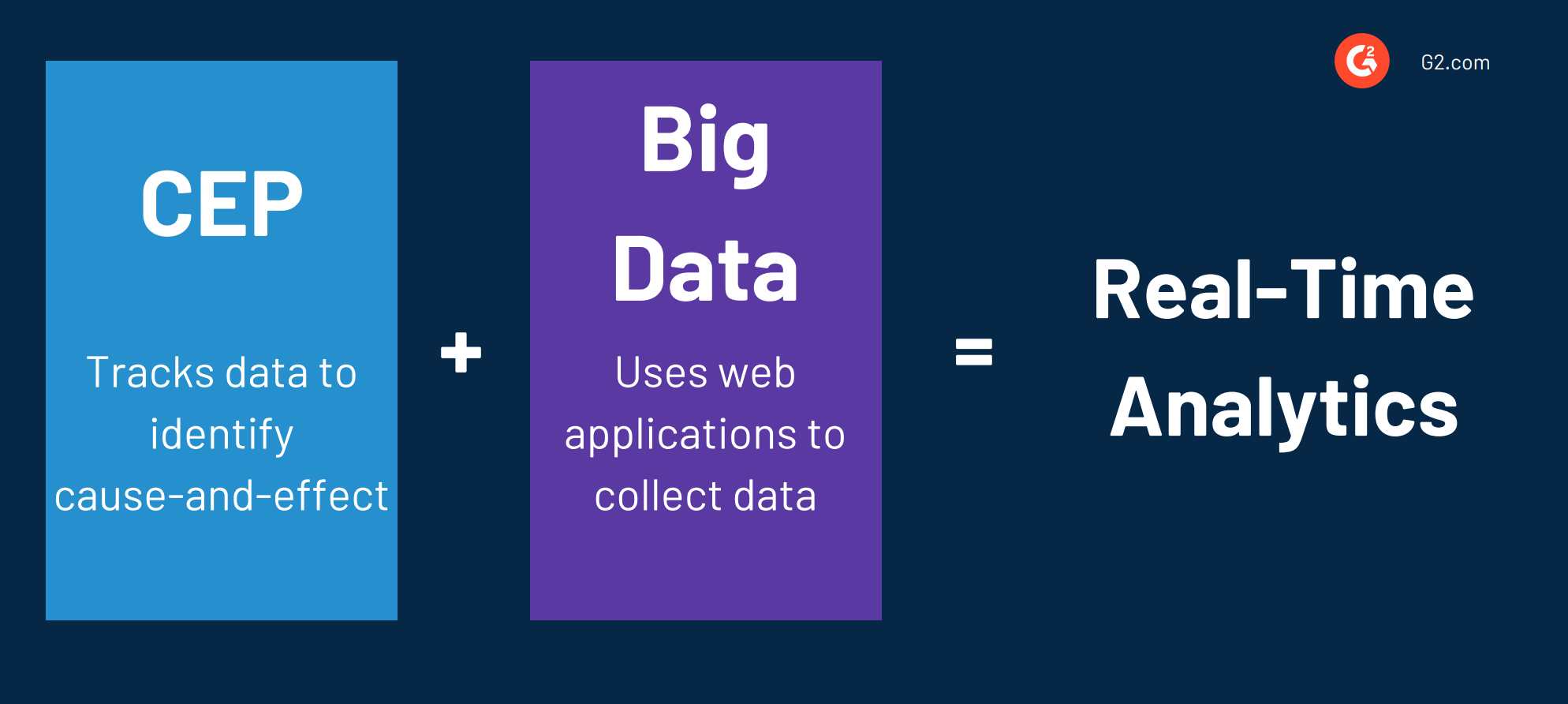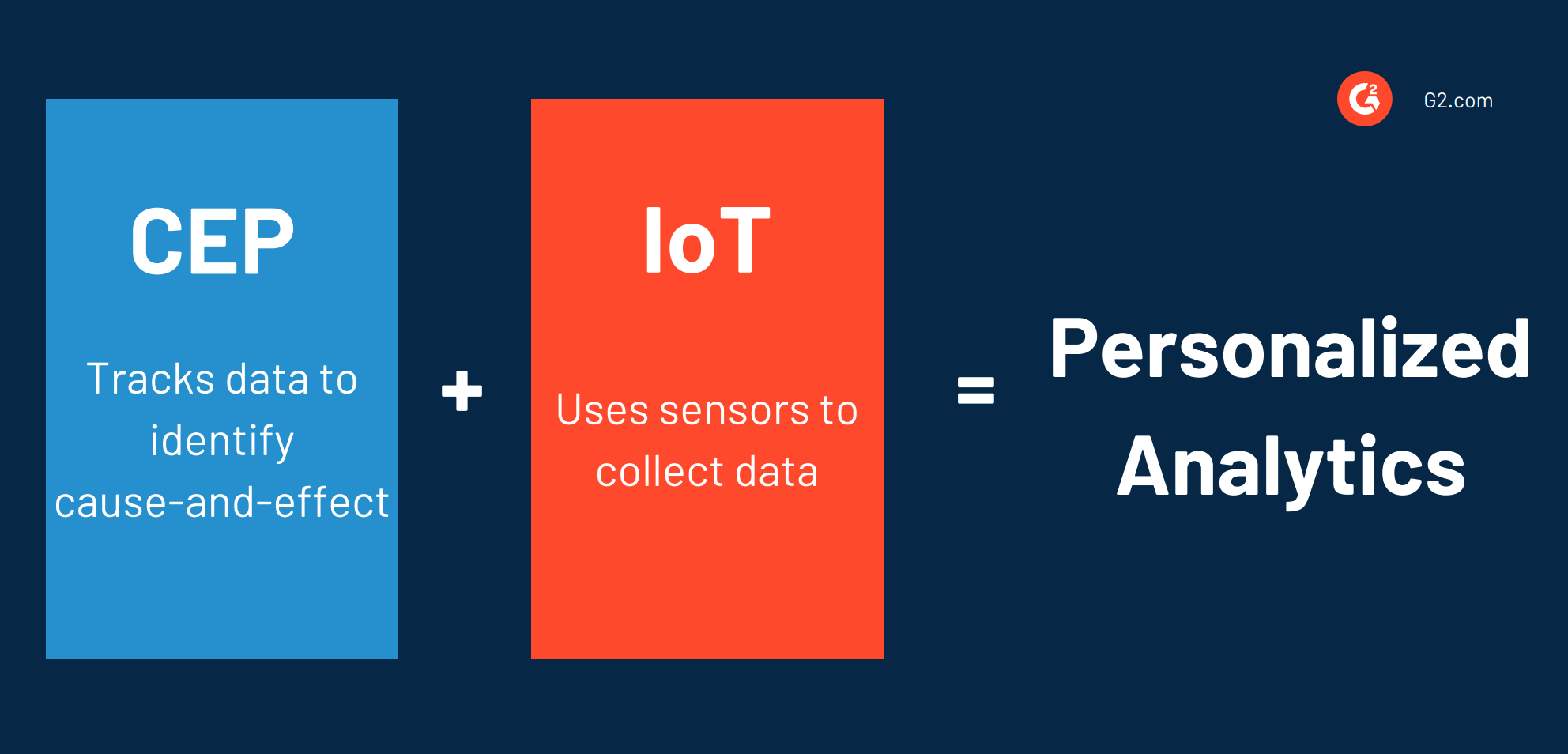We live in a fast-paced world where we depend on speedy actions and timely responses.
Whether that is a quick answer to a text message or getting our order in under three minutes when waiting at the drive-thru, our time is precious.
To keep up with the highly competitive market and need for instant responses, you have to expand the capabilities of the data processing tools you use to ensure you have top-notch data from business analytics. While these tools are where questions are asked, schemas are designed, and reports are delivered, sometimes you need something that takes it up a notch.
That’s where complex event processing (CEP) comes into play.
What is complex event processing?
Complex event processing (CEP) is the use of technology for querying data before storing it in a database. It is used to track and analyze streams of data that will identify cause-and-effect relationships amongst events in real-time to draw a conclusion about specific events.
An example of CEP finding patterns in events would be when a payment platform, that receives thousands of payment events a minute, tries to uncover fraudulent payments from patterns of purchases.
Complex event processing can also be referred to as event, stream, or event stream processing. And as the name suggests, it can be very… complex, no matter what you refer to it as. There's a lot to unravel, so let's get started.
How is complex event processing used?
This tool helps to collect a variety of information and data while also identifying and analyzing cause-and-effect relationships as they occur. It can provide an organization with the ability to define, manage, and predict events at rapid speeds.
CEP works to match incoming events against a pattern while providing insights into what is happening. It allows you to proactively take effective actions before it's too late.
In the case of CEP, an event can be anything from:
- A password change
- A stock purchase
- A transfer of funds
Complex events are typically referred to as important business events, like opportunities or threats that may arise. There is often the suggestion that these events will be responded to in real-time, or as quickly as possible, as that is one of the advantages of working with a CEP tool.
Major industries and areas in which CEP is applied are:
- Business Activity Monitoring: Identifying problems and opportunities in their early stage by observing business processes and other resources. It uses CEP to proactively define and analyze the most critical opportunities and risks within an organization. Some examples of this method are alert notifications and fraud detection.
- Sensory Networks: These networks are used to track industrial facilities. CEP does this thanks to raw numerical measurements. Some examples of this method are an increase in temperature and a large amount of smoke.
- Market Data: These consist of stock or commodity prices, which are derived from various events. Some examples of this method are the price of gas during the first half of the year and the rise and fall of stocks once a company goes public.
Information and data within CEP are usually stored and displaced within a network, power grid, database, or other large systems. This information then determines whether there has been an attack, if something isn’t performing optimally, or if a system is experiencing problems operating.
CEP is used for demanding, continuous-intelligence applications said to enhance situation awareness and support real-time decisions. It combines data from multiple sources to derive events or patterns, which provide companies with the ability to define, manage, and predict events, situations, and potential threats.
The events being analyzed by CEP software can happen across various channels within a business, such as sales leads, orders, or customer service calls. The data being collected can include text messages, social media posts, weather reports, stock market feeds, or traffic reports.
Related: Collecting data from text messages and social media reports are done using text mining, which is the process of extracting high-quality information from the text on apps and throughout the web.
Since CEP can conduct real-time event processing, organizations should use it with the end goal being real-time analytics. Especially since it’s always better to prevent an attack using predictive data than to attempt to rectify damage after the fact.
Complex event processing tools
Complex event stream processing software helps a user make conclusions from data drawn from different streams of information (or an event cloud). The ultimate goal of these tools is to uncover hard-to-find opportunities or threats from high-volume, rapidly occurring data that spans departments and many different sources.
CEP is quickly becoming the must-have tool that many organizations are utilizing, regardless of their industry. Businesses have never before had access to so much valuable data from markets, sensors, mobile devices, clickstream analysis, and other sources.
However, it can be difficult to know which system is right, as well as accidentally implementing the right system the wrong way. It’s important to plan for exactly what you need CEP for -- both in the present and in the future -- and if the tool can meet your needs.
Want to learn more about Event Planning Software? Explore Event Planning products.
History of CEP
The idea of CEP is rooted in similar processes, like discrete event simulation, various programming languages, and active database tools.
In the 1950s, operating systems would use “events” to schedule switching between areas of control on a single processor system. This idea was first called a discrete event simulation, which was any hardware design that could be modeled by a computer program written in a specific simulation language. Once it was given data, it could create events.
Complex event processing came about due to an increase in research projects taking place in the 1990s. The main instance was the Rapide project conducted by David Luckham at Stanford University, which paved the way for a generic CEP language and execution model.
He would come to write about his project in his 2002 book The Power of Events. Applications we now see in a variety of sectors of business are stock market trading systems, mobile devices, fraud detection, internet operations, the transportation industry, and government intelligence gathering.
In 2000, those working in the finance industry began to realize that machines could outperform humans, and by 2001, 20% of trades were assisted by computers. This grew to 66% of trades being handled electronically in 2013.
Until recently, there wasn’t much growth with CEPs outside of the financial industry. However, there has been an increase in the use of CEP in the airline industry. Many airlines have begun to use CEP to manage operational events, such as passenger check-in, baggage handling, and flight operations, or when a flight leaves a gate and when it lands.
By applying CEP to these events, an airline can better ensure the right bags are loaded onto the correct landing device, in addition to flights are leaving their gates and taking off on time.
CEP and big data
There’s no denying that big data is at the heart of analytics as it collects structured and unstructured data from web applications, server logs, and social media sites. We often attribute big data applications with getting real-time data feeds, but that is often not the case.
If that’s what your business wants from its big data, you’ll need to apply CEP. This tool will take on the challenge of putting your data in motion so it’s possible to gain actionable insights from it – fast. The two go hand-in-hand as CEP can process incoming data quickly by storing the information in the main memory of a computer.
By doing so, it turns big data into a real-time marketplace, which is something it won’t be able to achieve on its own. And since real-time capabilities are what people expect from their big data, CEP allows for better, and faster, outcomes.

CEP and business process management
Another natural fit for CEP software is with business process management (BPM) software, which helps organizations define and automate processes and deliver on various goals. Since BPM focuses on end-to-end business processes, CEP helps it to optimize and align for the best environment possible.
For the integration of these two tools to work, they have to exist on two levels.
First, there’s the business awareness level (when a user understands the benefit of what CEP can bring to the business), followed by the technological level (how CEP will be implemented within other tools, like BPM software). When they come together, this is referred to as Event-Driven Business Process Management.
This would provide a company with the ability to have situational awareness and be able to identify specific and complex correlations within these large amounts right after this data emerges. Doing so builds operational transparency for real-time reactions.
CEP and IoT
When it comes to real-time analysis, the challenge only grows as billions of sensors and small devices continue to collect more and more data.
Being able to react quickly when a situation is critical can be the difference between a company saving millions of dollars and one going bankrupt. This is one of the pillars of IoT functionality. Because of this, CEP is becoming a mainstream solution for IoT deployments.
As an example, consider the positive effects CEP and IoT can have on the healthcare industry.
Event processing for healthcare applications, specifically IoT-based applications that provide real-time data from medical devices with other patient and community data, offers multiple benefits that will lessen risk and increase the level of patient care since data will be analyzed as it happens. For example, if a patient’s blood pressure or temperature is too high, their provider will know immediately.
When you combine CEP and IoT with medical data, the door is opened for analytics that can be personalized for each patient and the monitoring device in which they’re wearing. The two working together can be used to predict and administer critical care when it’s needed – before it’s too late.

Insights at the speed of light
Okay, maybe not that fast, but there’s no denying that CEP allows businesses to rapidly sense, detect, and respond to a variety of situations.
Consider the benefit of fraud analysts being alerted immediately when a credit card number is used in different cities at the same time, or healthcare providers being able to check if a specific medication is covered by a patient’s insurance.
Both of these instances, and so many others, can be done using CEP. Make sure your organization is utilizing CEP to capture data at faster-than-ever speeds, while then analyzing and transforming it for usable intelligence.
Continue your deep dive into all that data can do by discovering the difference between structured and unstructured data.

Mara Calvello
Mara Calvello is a Content and Communications Manager at G2. She received her Bachelor of Arts degree from Elmhurst College (now Elmhurst University). Mara writes customer marketing content, while also focusing on social media and communications for G2. She previously wrote content to support our G2 Tea newsletter, as well as categories on artificial intelligence, natural language understanding (NLU), AI code generation, synthetic data, and more. In her spare time, she's out exploring with her rescue dog Zeke or enjoying a good book.
